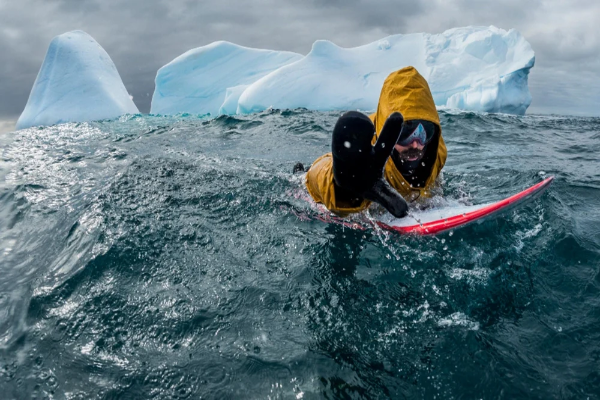Surfing in cold water presents unique challenges and rewards. While the frigid temperatures can be daunting, the thrill of catching waves in less crowded conditions can be immensely satisfying. With the right gear, preparation, and mindset, you can enjoy surfing even in the coldest conditions.
Understanding Cold Water Surfing
Surfing in cold water requires more than just a sturdy board and a brave heart. The water temperature can significantly affect your performance and safety. Cold water can sap your energy quickly and increase the risk of hypothermia. Therefore, it’s crucial to understand the specific needs and preparations for cold water surfing.
See Also: How to Bodyboarding with Fins
The Right Gear for Cold Water Surfing
- Wetsuits: The most critical piece of equipment for cold water surfing is a good quality wetsuit. A thick wetsuit, typically 4/3mm to 6/5/4mm, is essential for keeping you warm. Ensure that your wetsuit is well-fitted to prevent water from flushing through. Brands like O’Neill, Rip Curl, and Patagonia offer high-quality wetsuits designed for cold water conditions.
- Booties, Gloves, and Hood: In addition to a wetsuit, you’ll need booties, gloves, and a hood. These accessories help prevent heat loss from your extremities and head. A 5mm thickness for booties and gloves is standard, while hoods should be 3mm to 5mm thick.
- Surfboard Wax: Cold water wax is essential for maintaining grip on your board. Cold water wax is designed to remain sticky at lower temperatures, ensuring you have the traction you need.
Preparation and Safety
- Acclimatization: Before diving into cold water, it’s important to acclimatize your body. Gradually expose yourself to cold water in shorter sessions. This helps your body adjust and reduces the shock of cold temperatures.
- Warm-Up: A thorough warm-up routine is crucial. Stretching and light exercises increase blood flow and help keep your muscles flexible. This reduces the risk of injury and prepares your body for the cold water.
- Buddy System: Always surf with a buddy. Cold water can be dangerous, and having a friend nearby ensures you have help in case of an emergency.
- Know the Signs of Hypothermia: Hypothermia can set in quickly in cold water. Symptoms include shivering, confusion, fatigue, and loss of coordination. If you or your buddy exhibit these signs, get out of the water immediately and seek warmth.
Techniques for Cold Water Surfing
- Paddling: Cold water can make your muscles stiff. Focus on efficient paddling techniques to conserve energy. Keep your strokes smooth and maintain a steady rhythm.
- Duck Diving: Mastering the duck dive is crucial in cold water surfing. It helps you navigate through waves without expending too much energy. Practice your technique to ensure you can execute it smoothly.
- Wave Selection: In cold water, it’s essential to be selective about the waves you choose. Opt for waves that are within your skill level. This minimizes the risk of accidents and conserves your energy.
- Body Positioning: Maintain a low center of gravity on your board. This helps you stay balanced and reduces the impact of cold water on your performance.
Post-Surf Care
- Warming Up: After your surf session, warm up gradually. Change out of your wet gear as quickly as possible and into dry, warm clothes. Sip on a warm drink to raise your body temperature slowly.
- Hydration and Nutrition: Cold water surfing burns a lot of calories. Stay hydrated and consume nutrient-rich foods to replenish your energy. Hot soups and stews are excellent post-surf meals.
Mental Preparation
- Mindset: Cold water surfing can be mentally challenging. Stay positive and focus on the rewards. The solitude and beauty of cold water environments can be incredibly rewarding.
- Visualization: Use visualization techniques to prepare mentally. Imagine yourself successfully navigating waves and enjoying the surf. This can boost your confidence and performance.
Conclusion
Surfing in cold water is a unique and exhilarating experience. With the right gear, preparation, and mindset, you can conquer the cold and enjoy the waves. Remember to prioritize safety and listen to your body. Happy surfing!
FAQ: How to Surf in Cold Water
Q: Is it safe to surf in cold water?
A: Yes, but you need to take precautions. Wear a wetsuit and be aware of hypothermia risks.
Q: What kind of wetsuit should I wear?
A: Choose a wetsuit that fits snugly and is appropriate for the water temperature. Thickness can range from 3mm to 7mm.
Q: How do I stay warm while waiting for waves?
A: Stay active by paddling or treading water to generate body heat. You can also wear a neoprene hood and gloves.
Q: Can I still get sunburned in cold water?
A: Yes, UV rays can reflect off the water, so apply waterproof sunscreen and consider wearing a rash guard.
Q: How long can I stay in the water without risking hypothermia?
A: This depends on the water temperature and your physical condition. Monitor yourself for signs like shivering or confusion.
Q: Do I need special training to surf in cold water?
A: While not mandatory, taking a course on cold water survival skills can be beneficial.
Q: What if I fall in the water unexpectedly?
A: If you’re not prepared, try to get back on your board quickly. If you fall far from shore, float on your back to conserve energy.
Q: Should I surf alone in cold water?
A: It’s safer to have a partner or go with a group, especially in remote areas or during extreme conditions.
Q: What gear should I bring besides my wetsuit?
A: A leash, fins, and a board suitable for cold water conditions. Consider a helmet for rocky shore breaks.
Q: How can I improve my endurance for cold water surfing?
A: Gradually increase your time in the water and engage in other cold-water activities like swimming or diving to build tolerance.

